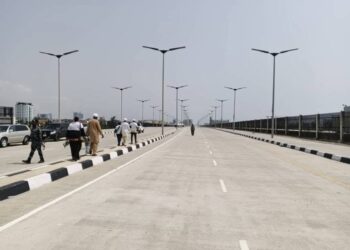Abuja – The Federal Government has confirmed that at least 500 persons died last few weeks due to the devastating impact of the floods in many parts of the country.
The figure was released on Tuesday at a meeting in Abuja convened by the FG comprising all relevant agencies of government connected to efforts at tackling the menace in the country.
The FG also revealed that 45,249 houses had been totally destroyed while 70,566 hectares of farmlands have been damaged.
But Minister of Agriculture and Rural Development, Dr. Mohammed Abubakar said though Nigerians could express concerns over the devastating floods, there should be no panic over threats to food security
In the same area, at least 600,000 people had been displaced, according to National Emergency Management Agency (NEMA).
Apart from the catastrophic flooding for states located along the courses of rivers Niger and Benue, at least three of Nigeria’s overfilled reservoirs have overflowed, causing havoc in its wake.
The Anambra tragedy followed the devastating aftermath of a flood that swept through swaths of neighbouring north-central Kogi state a week ago, leaving buildings submerged under water that rose to levels not seen in a decade, according to officials of the Kogi Red Cross Society.
Also heavily submerged are communities along the fringes of River Benue in Nasarawa State and River Niger traversing the boundary between Kwara and Niger states.
“Many people have been rendered homeless in Lokoja as houses were submerged by flood. The roads served as a link between North Central and Southern parts of the country and many passengers were stranded,” the Red Cross told the CNN.
Governor of Kogi State, Mr Yahaya Bello, had revealed that nine areas along the Niger and Benue River were affected.
“Ibaji is almost 100 per cent under water while the rest range from 30 per cent up … We therefore have a serious and humanitarian tragedy on our hands, but I wish to assure every person, family and community which has been affected that they are not alone and that help is coming,” he noted.
The situation in Kogi, had affected the movement of inter-state travellers, some of whom were stuck in traffic for days.
In addition, the situation had seriously impacted fuel supply in Abuja and environs as tankers from the southern part of the country have not been able to move beyond Kogi which serves as a gateway from the south to the north.
While displaced persons are now taking shelter in the homes of relatives and good Samaritans in neighbouring towns unaffected by the flood, Bello noted that he was working to reduce the impact of the flood.
One of the causes of the latest round of flooding, NEMA said, was the release of excess water from a dam in neighbouring Cameroon which it said was complicating Nigeria’s already disastrous flood crisis.
“The Lagdo dam operators in the Republic of Cameroun have commenced the release of excess water from the reservoir by 13th September, 2022. We are aware that the released water cascades down to Nigeria through River Benue and its tributaries thereby inundating communities that have already been impacted by heavy precipitation,” NEMA said recently.
But Kogi in the north central is not the only state reeling from the devastating impact of the latest flood. In neighbouring Nasarawa State, which is also grappling with flood water cascading down the River Benue, farmers are counting their losses from ravaged farmlands.
It’s the same in north-eastern Adamawa, where more people are dying from flood-related incidents.
In the South-East too due to River Niger bursting its banks around Onitsha and Ogbaru, many houses are now also submerged.
One of the biggest impacts of the flooding it was learnt would be food shortage as farmers in the north cannot move their produce and animals to the south while tanker drivers cannot move fuel to the North.
Areas mostly impacted in Anambra aside Ogbaru and Onitsha North are Onitsha South, Anambra East, Anambra West, Awka North, Ayamelum and Oyi local government areas.
In Kogi, the popular Ganaja road leading to Ajaokuta, Kogi East and Eastern part have been submerged while oncoming have had to park by the roadside.
The situation is also expected to affect the price of rice around December as Olam Nigeria Limited, one of Nigeria’s biggest agri-business companies, said the massive flooding from River Benue damaged the company’s crops and infrastructure.
Vice-president, Olam Nigeria Limited, Ade Adefeko had said the incident affected the company’s $20 million investment and about 25 percent of Nigeria’s rice needs, describing the situation as “very terrible.”
“The entire team from the farm worked very hard to prevent the colossal damage…but it affected us to a large extent. We supply about 25 per cent of Nigeria’s rice needs and that has been affected and have lost over $20 million,” he said.
“When they say it rains. It’s not really raining, it’s pouring. So it’s terrible” he added.
The Olam Rice Farm is located in Lukubi Doma Local Government Area of Nasarawa State. The farm sits on 10,000 hectares and is one of the largest rice farms in Nigeria and Africa with N140 million worth of investment.
But the Permanent Secretary, Federal Ministry of Humanitarian Affairs, Disaster Management and Social Development, Sani Gwarzo, while releasing the latest statistics Tuesday, told journalists that the government was working hard to address the situation.
“In the area of the flood disaster outlook, records from the field have indicated that the 2022 flood is comparable only to the 2012 flood in terms of human displacement, livelihood disruption, infrastructure damage and environmental dislocation.
“The National Emergency Management Agency has confirmed that as at October 9, 2022, water levels at Lokoja and Makurdi along Rivers Niger and Benue is 11 per cent above the level recorded in 2012.
“So far the flood has wreaked havoc in 31 states of the federation and the Federal Capital Territory (FCT). Over 500 persons are reported dead; 1,411,051 affected; 790,254 displaced persons with 1,546 persons injured.
“Furthermore, 44,099 houses are partially damaged; 45,249 houses totally damaged; 76,168 hectares of farmland partially damaged and 70,566 hectares of farmland are completely destroyed by the great deluge,” he revealed.
He added that relief materials were being made available to persons in need, stressing that NEMA had provided relief support to over 315,000 displaced persons across the flood disaster hotspots where state capacities had been overwhelmed.

















